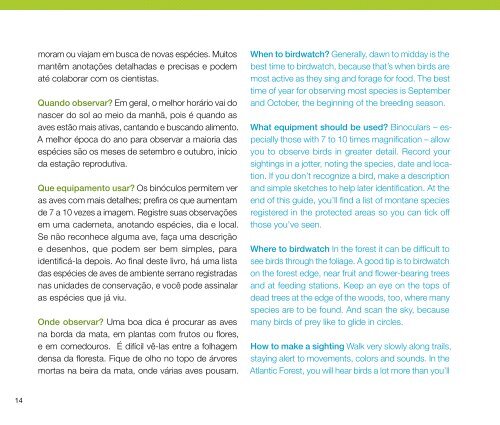Guia de aves Mata Atlântica Paulista - Secretaria do Meio Ambiente
Guia de aves Mata Atlântica Paulista - Secretaria do Meio Ambiente
Guia de aves Mata Atlântica Paulista - Secretaria do Meio Ambiente
Create successful ePaper yourself
Turn your PDF publications into a flip-book with our unique Google optimized e-Paper software.
moram ou viajam em busca <strong>de</strong> novas espécies. Muitos<br />
mantêm anotações <strong>de</strong>talhadas e precisas e po<strong>de</strong>m<br />
até colaborar com os cientistas.<br />
Quan<strong>do</strong> observar Em geral, o melhor horário vai <strong>do</strong><br />
nascer <strong>do</strong> sol ao meio da manhã, pois é quan<strong>do</strong> as<br />
<strong>aves</strong> estão mais ativas, cantan<strong>do</strong> e buscan<strong>do</strong> alimento.<br />
A melhor época <strong>do</strong> ano para observar a maioria das<br />
espécies são os meses <strong>de</strong> setembro e outubro, início<br />
da estação reprodutiva.<br />
Que equipamento usar Os binóculos permitem ver<br />
as <strong>aves</strong> com mais <strong>de</strong>talhes; prefira os que aumentam<br />
<strong>de</strong> 7 a 10 vezes a imagem. Registre suas observações<br />
em uma ca<strong>de</strong>rneta, anotan<strong>do</strong> espécies, dia e local.<br />
Se não reconhece alguma ave, faça uma <strong>de</strong>scrição<br />
e <strong>de</strong>senhos, que po<strong>de</strong>m ser bem simples, para<br />
i<strong>de</strong>ntificá-la <strong>de</strong>pois. Ao final <strong>de</strong>ste livro, há uma lista<br />
das espécies <strong>de</strong> <strong>aves</strong> <strong>de</strong> ambiente serrano registradas<br />
nas unida<strong>de</strong>s <strong>de</strong> conservação, e você po<strong>de</strong> assinalar<br />
as espécies que já viu.<br />
On<strong>de</strong> observar Uma boa dica é procurar as <strong>aves</strong><br />
na borda da mata, em plantas com frutos ou flores,<br />
e em come<strong>do</strong>uros. É difícil vê-las entre a folhagem<br />
<strong>de</strong>nsa da floresta. Fique <strong>de</strong> olho no topo <strong>de</strong> árvores<br />
mortas na beira da mata, on<strong>de</strong> várias <strong>aves</strong> pousam.<br />
When to birdwatch Generally, dawn to midday is the<br />
best time to birdwatch, because that’s when birds are<br />
most active as they sing and forage for food. The best<br />
time of year for observing most species is September<br />
and October, the beginning of the breeding season.<br />
What equipment should be used Binoculars – especially<br />
those with 7 to 10 times magnification – allow<br />
you to observe birds in greater <strong>de</strong>tail. Record your<br />
sightings in a jotter, noting the species, date and location.<br />
If you <strong>do</strong>n’t recognize a bird, make a <strong>de</strong>scription<br />
and simple sketches to help later i<strong>de</strong>ntification. At the<br />
end of this gui<strong>de</strong>, you’ll find a list of montane species<br />
registered in the protected areas so you can tick off<br />
those you’ve seen.<br />
Where to birdwatch In the forest it can be difficult to<br />
see birds through the foliage. A good tip is to birdwatch<br />
on the forest edge, near fruit and flower-bearing trees<br />
and at feeding stations. Keep an eye on the tops of<br />
<strong>de</strong>ad trees at the edge of the woods, too, where many<br />
species are to be found. And scan the sky, because<br />
many birds of prey like to gli<strong>de</strong> in circles.<br />
How to make a sighting Walk very slowly along trails,<br />
staying alert to movements, colors and sounds. In the<br />
Atlantic Forest, you will hear birds a lot more than you’ll<br />
14

















